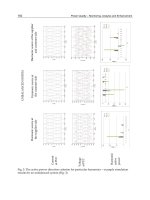Flash Memories Part 8 pdf
Bạn đang xem bản rút gọn của tài liệu. Xem và tải ngay bản đầy đủ của tài liệu tại đây (528.85 KB, 20 trang )
Survey of the State-of-the-Art
in Flash-based Sensor Nodes 17
three main type of applications: 1) file systems to store both internal and external data;
2) data-centric middlewares that provide an abstraction of the sensors n etwork as a long
database; and 3) applications for network reprogramming. These three types of applications
use the flash m emory chip a s data storing support. Note that in a four category should appear
the applications that use the flash for s pecific purposes. Figure 6 shows this classification. In
following subsections we review some relevant examples in each category.
Fig. 6. A classification of applications that use the flash memory chip.
4.1 File systems
In addition to the OS-specific file systems presented in the previous section, we review here
two file systems that were designed with no regard to be OS-independent: ELF and SENFIS.
The usage of file systems is justified: the continuous data production through a wide set of
versatile applications d rives researchers to think about different methods of data storing and
recovering, which can provide an efficient abstraction to give persistent support to the data
generated into the sensor node.
4.1.1 ELF
ELF (Dai et al., 2004) is a file system for WSNs based on the log file system
paradigm (Kawaguchi et al., 1995). The major goals of ELF are memory efficiency, low power
operation, and support for common file operations (such as reading and appending data to
a file). The data to be stored in files are classified into three categories: data collected from
sensors, configuration data, and binary program images. The access patterns and reliability
requirements of these categories of data are different. Typically, the reliability of sensor data is
verified through the CRC checksum mechanism. For binary images a greater reliability may
be desirable, such as recovery after a crash. Typically, traditional log-structured file systems
group log entries for each write operation into a sequential log. ELF keeps each log entry in a
separate log page due to the fact that, if multiple log entries are stored on the same page, an
error o n this page will destroy all the history saved until that moment. ELF also provides a
simple garbage collection mechanism and crash recovery support.
4.1.2 SENFIS
SENFIS (Escolar et al., 2008; 2010) is a file system designed for Mica family motes and
intended to be used in two scenarios: firstly, it can transparently be employed as a
permanent storage for distributed TinyDB queries (see next subsection), in order to increase
their reliability and scalability; secondly, it can be directly used by a WSN application for
129
Survey of the State-of-the-Art in Flash-Based Sensor Nodes
18 Will-be-set-by-IN-TECH
Primitive Prototype Description
int8_t open (char *filename, uint8_t mode) Open a file
result_t close (uint8_t fd) Close a file
int8_t write (uint8_t fd, char *buffer, int8_t length) Append data to a file
int8_t read (uint8_t fd, char *buffer, int8_t length) Read from a file
result_t rename(char *oldname, char *newname) Rename a file
result_t lseek (uint8_t fd, uint32_t ptr) Update the offset of a file
result_t stat(uint8_t f d, struct inode *inode) Obtain metadata of a file
result_t delete (uint8_t fd) Delete a file
Table 11. Basic high-level interface for SENFIS.
permanent storage of data on the motes. SENFIS uses the flash for persistent storage and
RAM as a volatile memory. The flash chip is divided into blocks called segments, whose
pages are accessed in a circular way, guaranteeing an optimal intra-segment wear levelling.
The global wear-levelling is a best-effort algorithm: a newly created file is always assigned
the lowest used segment.
In SENFIS, the flash is organized in segments. For instance, for AT45DB041 the flash may
consist of 64 segments of 32 pages each. Each segment may be assigned to at most one file
but a file can use an ar bitrary number of segments. A segment is written always sequentially
in a circular way. For implementing this behaviour a pointer to the last written page is kept
in the segment metadata structure which is stored in a segment table.Everysegmentinthis
table records a pointer to the first page of the segment, a pointer to the next segment as well
as a counter i ndicating the number o f times the pages of this segment have been written. To
minimize the number of times that a page fl ash is accessed the reading and writing operations
use an intermediate cache such as shown in Figure 7. SENFIS provides a POSIX-style interface
which is shown in Table 11.
SENFIS uses a writing buffer to reduce the number of times that a page is accessed. Figure 7
shows graphically this behaviour.
4.2 Data-centric middlewares
The most common approach to bridge the gap between the applications and low-level
software, has been to develop a middleware layer mapping one level into the other. A
survey of middleware is given in (Marrón, 2005) where a taxonomy o f middlewares is
discussed. In particular, authors identify data-centric middlewares as those ones that o perate
the sensor network as a database abstraction. Most of them rely on some form of SQL-like
language in order to recover the data stored in different memories within the sensor node
(RAM, E EPROM, and e xternal flash). There exist different data-centric middlewares such
as Cougar (Fung et al., 2002), TinyBD (Madden et al., 2005), DSWare (Li et al., 2003) and
SINA (Jaikaeo et al., 2000)); some of them are summarized in the following paragraphs.
4.2.1 T inyDB
TinyDB (Madden et al., 2005) focuses on acquisitional query processing techniques which
differ from other database query techniques for WSN in that i t does not simply postulate
the a priori existence of data, but it focuses also on location and cost of acquiring data. The
acquisitional techniques have been shown to reduce the power consumption in several orders
of magnitude and to increase the accuracy of query results. A typical query of TinyDB is active
130
Flash Memories
Survey of the State-of-the-Art
in Flash-based Sensor Nodes 19
Fig. 7. Writing and reading operations in SENFIS: 1) Above, the writing operation which
appends data to the end of a file. The modification is done in a small buffer cache in RAM
and it is committed to the flash either when a page is completely written or when the RAM is
full. The first case tries to avoid that a page is committed to flash several times for small
writes; 2) below, the reading operation which g et the data from the flash to an application
buffer. If the data is already in the small buffer cache, it is copied to the application buffer
from there.
in a mote for a specified time frame and is data in tensive. The r esults of a query may produce
communication or be temporarily stored in the RAM memory. In TinyDB the sampled values
of the various sensor attributes (e.g. temperature, light) are stored in a table called sensors.
The columns of the table represent the sensor attributes and the rows the instant of time
when the measure was taken. Projections and transformations of sensor table are stored in
materialization points. A materialization point is a type of temporal table that can be used in
subsequent select operations. Materialization points are declared by the u sers and correspond
to files in our system. TinyDB query syntax is s imilar to SQL
SELECT-FROM-WHERE-GROUPBY
clause, supporting selection, join, projection and aggregation. In addition TinyDB provides
SAMPLE PERIOD clause defining the overall time of the sampling called epoch and the period
between consecutive samples. The materialization points are created by
CREATE STORAGE
POINT
clause, associated with a SELECT clause, which selects data either from the sensor
table or from a different materialization point.
4.2.2 Cougar
Cougar (Fung et al., 2002) is another data-centric middleware approach intended to address
the goals of scalability and flexibility in monitoring the physical world. In Cougar system
sensor nodes are organized in clusters and they can assume two roles: cluster leader or signal
processing nodes. The leaders receive t he q ueries and plan how t hey must be executed within
of a cluster; in particular, they must decide what nodes the query should be sent to, and keep
waiting for the response. On the other hand, signal processing nodes generate data from
131
Survey of the State-of-the-Art in Flash-Based Sensor Nodes
20 Will-be-set-by-IN-TECH
their sensor readings. Signal processing functions are modelled by using Abstract Data Type
(ADT). Like TinyDB, Cougar uses a SQL-like language to implement queries.
4.3 Network reprogramming applications
Code dissemination for network reprogramming is nowadays one of the important issues
in the WSN field. WSN applications are conceived to execute for the maximum period of
time. However, during their lifetime is very probable that the application needs to be total or
partially updated. There are several reasons for it as to meet new requirements or to correct
errors detected at execution time. There exist in the literature a large set of applications that
enables this feature. Despite every particular implementation, a common characteristic of all
of them is the employment of the flash memory to store the updates that are received from
the network. In fact, there is no other choice due to the limited capacity of the node RAM
memory. According to (Munawar et al., 2010) applications for remote reprogramming can be
classified in four main categories:
• Full-image replacement: the first approach for network reprogramming operated
disseminating in the network a new image to replace the current application running in
the nodes. Examples of this type o f reprogrammers are Deluge and XNP, which are both
TinyOS 1.x specific. In a first step, the image was received from the network and locally
stored in the node flash. Once the packet reception was completed, the sensor node reboots
which makes a copy of the binary stored in the flash into the microcontroller. The main
disadvantage of this approach is that even for small updates the transmission of the full
image should be done, which impacts negatively on the waste of energy in the sensor node.
• Virtual machines: with the goal of reducing the energy consumption in which the previous
approach incurs, there exist different works that propose disseminating virtual machine
code (byte-code) instead of native code, since the first is in general more compact than the
second one. The most relevant example is Mate (Levis & Culler, 2002). Maté disseminates
to the network packets denominated capsules which contain the binary to be installed.
In the sensor nodes the byte-code is interpreted and installed in the sensor node. The
advantage of this approach is that reduces significantly the program size that travels
through the network, which decreases the energy consumption due to the communication
as well as the storing cost.
• Dynamic operating systems: there exists WSN operating systems that include support for
the dynamic reprogramming of sensor nodes. For example, in Contiki applications can
be more easily updated, due t o the fact that Contiki supports load dynamic of programs
on the top of the operating system kernel. In this way, code updates can be remotely
downloaded into the network. There are, however, certain restrictions to perform this since
only application components can be modified. LiteOS (Cao et al., 2008) is another example
of this type of OSes. LiteOS provides dynamic reprogramming at the application level
which means that the operating system image can no t be updated. To d o this it manages
the modified H EX files instead u sing E LF files —as Contiki— in order to store relocation
information.
• Partial-image replacement approach is based on disseminate only the changes between
the current executable installed in the network and the new version of the same
application. This is the most efficient solution since only is sent the piece of code that
132
Flash Memories
Survey of the State-of-the-Art
in Flash-based Sensor Nodes 21
needs to be updated. There are in the literature several works using this approach.
Zephyr (Panta et al., 2009) compares the two binary images at the byte-level and send
only a small delta, reducing the size o f data to be s ent. FlexCup (Marrón et al., 2006)
is an efficient code update mechanism that allows the replacement of TinyOS binary
components. FlexCup is specific for Ti nyOS 1.x and does not include the new extensions of
nesC. Dynamic TinyOS (Munawar et al., 2010) preserves the modularity of TinyOS which
is lost during the compilation process and enables the composition of the application at
execution time.
5. Conclusions
Through this chapter we have analyzed the main features of the flash memory chip as well
as their main applications within the wireless sensor networks field. We have described
the different technologies employed i n the manufacturing of flash memory given specific
examples used by the sensor nodes. The sensor node architecture has been presented while
the flash memory has been introduced as an important component that possibilities a great
amount of usages which would not be possible without its presence.
We have described some relevant WSN operating systems highlighting the different
abstractions that they provide at the application level in order to access the data stored in
the flash. As discussed, in general the portability has been sacrificed and the implementation
is typically device-specific. The abstraction level provided by the OSes is very low since the
application must manage hardware level details such as the number of the page to be read or
written and the offset wi thin the page, which make complex the applications programming.
To alleviate this problem, the operating systems can supply a basic implementation of a file
system to facilitate the data access. Here, the users manipulate abstract entities called file
descriptors which allow to uncouple the data from its physical location. Subsequently, file
systems simplify the data access but in general they do not completely address the issues
regarding to the flash memory such as the implementation of wear levelling techniques to
prevent reaching the maximum number of times that a page can be written. For t his reason,
the literature presents some other file systems that has been proposed in order to improve the
features or the performance of the existing files systems included into the operating systems.
Recently, the attention paid to the flash memory chip trends to grow due to the a ppearance
of new applications that will use the flash memory to perform their tasks. Since the flash
chip represents the device with the bigger capacity for permanent storage of application data
in the sensor node, there exist an increasing number of applications that require its usage to
be able to satisfy their requirements, for example, applications for dynamic reprogramming.
Finally in this chap ter, we have identified a taxonomy of WSN applications that uses the flash
memory providing specific examples of applications in each category of the taxonomy. We
will envision that the number of emerging applications that will use the flash memory as
basis for their operations will continue increasing.
6. Acknowledgements
This work has been partially funded by the Spanish Ministry of Science and Innovation under
the grand TIN2010-16497.
133
Survey of the State-of-the-Art in Flash-Based Sensor Nodes
22 Will-be-set-by-IN-TECH
7. References
Akyildiz, I. F., Su, W., Sankarasubramaniam, Y. & Cayirci, E. (2002). Wireless sensor networks:
asurvey.,Computer Networks 38(4): 393–422.
Atmel (2011). Atmel 8-bit AVR microcontroller Datasheet, Available in:
URL: .
Atmel AT45DB011 Serial DataFlash ( 2001). U RL: />T/4/5/AT45DB.shtml.
Balani, R., chieh Han, C., Raghunathan, V. & Srivastava, M. (2005). Remote storage for sensor
networks.
Cao, Q. & Abdelzaher, T. (2006). LiteOS: a lightweight operating system for C++ software
development in sensor networks, SenSys ’06: Proceedings of the 4th international
conference on Embedded networked sensor systems, ACM, New York, NY, USA,
pp. 361–362.
Cao, Q., Stankovic, J. A., Abdelzaher, T. F. & He, T. (2008). LiteOS, A Unix-like operating
system and programming platform for wireless sensor networks, Information
Processing in Sensor Networks(IPSN/SPOTS),St.Loius,MO,USA.
CC1000 Single Chip Very Low Power RF Transceiver (2002).
URL: />CC2400 2.4GHz Low-Power RF Transceiver (2003).
URL: />Dai, H., Neufeld, M. & Han, R. (2004). Elf: an e fficient log-structured flash file system for micro
sensor nodes, SenSys ’04: Proceedings of the 2nd international conference on Embedded
networked sensor systems, ACM, New York, NY, USA, pp. 176–187.
Diao, Y., Ganesan, D., Mathur, G. & Shenoy, P. ( 2007). Rethinking data management for
storage-centric sensor networks.
Dunkels, A., Gronvall, B. & Voigt, T. (2004). Contiki - a lightweight and flexible operating
system for tiny networked sensors, Proceedings of the 29th Annual IEEE International
Conference on Local Computer Networks, LCN ’04, IEEE Computer Society, Washington,
DC, USA, pp. 455–462.
URL: />Escolar, S., Carretero, J., Isaila, F. & Lama, S. (2008). A lightweight storage system for sensor
nodes, in H. R. Arabnia & Y. Mun (eds), PDPTA, CSREA Press, pp. 638–644.
Escolar, S., Isaila, F., Calderón, A., Sánchez, L. M. & Singh, D. E. (2010). Senfis: a sensor node
file system for increasing the scalability and reliability of wireless sensor networks
applications, The Journal of Supercomputing 51(1): 76–93.
Fung, W. F., Sun, D. & Gehrke, J. (2002). Cougar: the network is the database, Proceedings of
the 2002 ACM SIGMOD international conference on Management of data, SIGMOD ’02,
ACM, New York, NY, USA, pp. 621–621.
URL: />Gay, D. (2003). The Matchbox File System,
URL: />Gay, D., Levis, P., von Behren, R., Welsh, M., Brewer, E. & Culler, D. (2003). The nesc language:
A holistic approach to networked embedded systems, PLDI ’03: Proceedings of the
ACM SIGPLAN 2003 conference on Programming language design and implementation,
ACM, New York, NY, USA, pp. 1–11.
134
Flash Memories
Survey of the State-of-the-Art
in Flash-based Sensor Nodes 23
Han, C C., Kumar, R., Shea, R., Kohler, E. & Srivastava, M. (2005). A dynamic
operating system for sensor nodes, Proceedings of the 3rd international conference on
Mobile systems, applications, and services, MobiSys ’05, ACM, New York, NY, USA,
pp. 163–176.
URL: />Handziski, V., Polastrey, J., Hauer, J H., Sharpy, C., Wolisz, A. & Culler, D. (2005). Flexible
Hardware Abstraction for Wireless Sensor Networks, 2nd European Workshop on
Wireless Sensor Networks (EWSN 2005), Istanbul, Turkey.
Hill, J., Szewczyk, R., Woo, A., Hollar, S., Culler, D. & Pister, K. (2000). System architecture
directions for networked sensors, SIGPLAN Not. 35: 93–104.
URL: />Instrument, T. (2008). Msp430x1xx 8mhz datasheet, Available in: URL:
.
Intel Strataflash (2002).
URL: />Jaikaeo, C., Srisathapornphat, C. & chung Shen, C. (2000). Querying and tasking in sensor
networks.
Kawaguchi, A., Nishioka, S. & Motoda, H. (1995). A flash-memory based file system, USENIX
Winter, pp. 155–164.
URL: citeseer.ist.psu.edu/kawaguchi95flashmemory.html
Levis, P. & Culler, D. (2002). Mate: a tiny virtual machine for sensor networks, ASPLOS-X:
Proceedings of the 10th international conference on Architectural support for programming
languages and operating systems, ACM, New York, NY, USA, pp. 85–95.
Li, S., Lin, Y., Son, S. H., Stankovic, J. A. & Wei, Y. (2003). Event detection services using data
service middleware in distributed sensor networks.
M25P40 Serial Flash Memory (2002).
URL: .
Madden, S. R., Franklin, M. J., Hellerstein, J. M. & Hong, W. (2005). TinyDB: an
acquisitional query processingsystem for sensor networks, ACM Trans. Database Syst.
30(1): 122–173.
Marrón, P. J. (2005). Middleware approaches for sensor networks. University of Stuttgart,
Summer School on WSNs and Smart Objects. Schloss Dagstuhl, Aug. Germany. URL:
/>Marrón, P. J., Gauger, M., Lachenmann, A., Minder, D., Saukh, O. & Rothermel, K. (2006).
Flexcup: A flexible and efficient code update mechanism for sensor networks.
URL: />Munawar, W. , Alizai, M. H., L, O. & Wehrle, K. (2010). Dynamic tinyos: Modular and
transparent incremental code-updates for sensor networks.
nRF2401 Radio Transceiver Data Sheet (2003). URL: />Panta, R. K., Bagchi, S. & Midkiff, S. P. (2009). Z ephyr: ef ficient incremental reprogramming of
sensor nodes using function call indirections and difference computation, Proceedings
of the 2009 conference on USENIX Annual technical conference, USENIX’09, USENIX
Association, Berkeley, CA, USA, pp. 32–32.
URL: />SAMSUNG (2003). Samsung K9K1G08R0B, 128M x 8 bit NAND Flash Memory.
135
Survey of the State-of-the-Art in Flash-Based Sensor Nodes
24 Will-be-set-by-IN-TECH
Shenker, S., Ratnasamy, S., Karp, B ., Govindan, R. & Estrin, D. (2003). Data-centric storage in
sensornets, SIGCOMM Comput. Commun. Rev. 33(1): 137–142.
Tsiftes, N., Dunkels, A., He, Z. & Voigt, T. (2009). Enabling Large-Scale Storage in Sensor
Networks with the Coffee File System, Proceedings of the 8th ACM/IEEE International
Conference on Information Processing in Sensor Networks (IPSN 2009), San Francisco,
USA.
URL: adam/tsiftes09enabling.pdf
Xu, N. (2002). A survey of sensor network applications, IEEE Communications Magazine 40.
136
Flash Memories
0
Adaptively Reconfigurable Controller
for the Flash Memory
Ming Liu
1,2
, Zhonghai Lu
2
,WolfgangKuehn
1
and Axel Jantsch
2
1
Justus-Liebig-University Giessen
2
Royal Institute of Technology
1
Germany
2
Sweden
1. Introduction
As the continuous development on the capacity and work frequency, Programmable
Logic Devices (PLD) especially Field-Programmable Gate Arrays (FPGA) are playing an
increasingly important role in embedded systems designs. T h e FPGA market has hit about
3 and 4 billion US dollars respectively in 2009 and 2010, and is expected by Xilinx CEO Moshe
Gavrielov to grow steadily to 4.5 billion by the end of 2012 and 6 billion by the end of 2015.
The application fields of FPGAs and other PLDs range from bulky industrial and military
facilities to portable computer devices or communication terminals. Figure 1 demonstrates
the market statistics of some most significant fields in the third quarter of 2009.
Fig. 1. PLD market by end applications in the third quarter of 2009 (Dillien, 2009)
FPGAs were originally used as programmable glue logic in the early period after its birth. Due
to the capacity and clock frequency constraints at that ti me, they typically worked to bridge
Application-Specific Integrated Circuit (ASIC) chips by adapting signal formats or conducting
simple logic calculation. However at present, modern FPGAs have obtained enormous
capacity and many advanced computation/communication features from the semiconductor
process development; they can accommodate complete computer systems consisting of
hardcore or softcore microprocessors, memory controllers, customized hardware accelerators,
7
2 Will-be-set-by-IN-TECH
as well as peripherals, etc. Taking advantage of design IP cores and interconnection
architecture, it has become a reality to easily implement System-on-Programmable-Chip
(SoPC) or system-on-an-FPGA.
In spite of large advances, the chip area utilization efficiency as well as the clock speed of
FPGAs is still very low in comparison with ASICs. One of the reasons is that FPGA employs
Look-Up Table (LUT) to construct combinational logic, rather than primary gates as in ASICs.
In (Kuon & Rose, 2006), the authors have measured FPGAs to be 35X larger in area and 3X
slower in speed than a standard cell ASIC flow, both using 90-nm technology; In (Lu et a l.,
2008), a 12 year old Pentium
design was ported on a Xilinx Virtex-4 FPGA. A 3X slower
system speed (25 MHz vs. 75 MHz) is still observed, although the FPGA uses a recent
90-nm technology while the original ASICs were 600-nm. The speed and area utilization gap
between FPGAs and ASICs has been additionally quantified in (Zuchowski et al., 2002) and
(Wilton et al., 2005) for various designs. Therefore we understand that FPGA programmable
resources are still comparatively expensive. Efficient resource management and utilization
remain to be a challenge especially for those applications with simultaneous high performance
and low cost requirements.
Flash memory is often used to store nonvolatile data in embedded systems. Due to its
intrinsic access mode, normally it does not feature as high speed read and write operations
as volatile memories such as Dynamic Random Access Memory (DRAM) or Static Random
Access Memory (SRAM). In many applications, flash memory is only used to hold data or
programs which are expected to be retrievable after each time power off. It is only addressed
very occasionally or even never during the system run-time, when those data or programs
have already been loaded in the main memory of the system. For example, an embedded
Operating System (OS) kernel may be loaded from the flash into DDR for fast execution in
case of system power-on. Afterwards, the flash memory will never be addressed in systems
operation unless the OS kernel is scheduled to be updated. Because of the occasionality of
flash accesses, it generates resource utilization inefficiency if the flash memory controller is
statically mapped on the FPGA design but does not operate frequently.
In the recent years, an advanced FPGA technology called Dynamic Partial Reconfiguration
(DPR or PR) has emerged and become gradually mature for practical designs. It offers
the capability to dynamically change part of the design without disturbing the remaining
system. Based on the FPGA PR technology, which enables more efficient run-time resource
management, we present a peripheral controller reconfigurable system design in this chapter:
A NOR flash memory controller can be multiplexed with other peripheral components (in
the case study an SRAM controller), time-sharing the same hardware resources with all
the required system functionalities realized. We will elaborate the design in the following
sections.
2. Conventional static design on FPGAs
2.1 Static design approach
A peripheral controller is the design component which interfaces to the peripheral device
and interprets or responds to access instructions from the CPU or other master devices. So a
flash memory controller is the design by which CPU addresses external flash chips. Figure 2
shows the top-level block diagram of a flash memory controller for the Processor Local Bus
138
Flash Memories
Adaptively Reconfigurable Controller
for the Flash Memory 3
(PLB) (IBM, 2007) connection. It receives control commands from the PLB to read from and
write to external memory devices. The controller design provides basic read/write control
signals, as well as the ability to configure the access time for read, write, and recovery time
when switching between read and write operations. In addition, the memory data width and
the bus data width are p a rameterizable. They can be automatically matched by performing
multiple memory cycles when the memory data width is less than PLB. This design structure
is capable of realizing both synchronous and asynchronous device access. It may also support
other parallel memory accesses with small modification effort, such as SRAM.
Fig. 2. Top-level block diagram of the PLB flash memory controller (Xilinx, 2006)
Figure 3 demonstrates a typical system-on-an-FPGA design for embedded applications. As an
example, we adopt the Xilinx Virtex-4 FX FPGA for the implementation. We observe that all
components are interconnected by the PLB, including the microprocessor,memory controllers,
the application-specific algorithm accelerator as well as peripheral devices. In case of system
power-on, the FPGA firmware bitstream is firstly downloaded to configure the FPGA via a
special configuration interface (Dunlap & Fischaber, 2010). Afterwards an embedded Linux
OS kernel is loaded by a bootloader program into the main memory of DDR for fast execution.
In the design, a NOR flash memory stores nonvolatile data necessary for system startup in the
field, including both the bitstream file and the OS kernel.
Suppose we are constructing a system aiming at memory bandwidth hungry computation
for certain applications. Hence a Zero-Bus Turnaround ( ZBT) SRAM is integrated in the
system in addition to the main DDR memory. The SRAM is utilized as a Look-Up Table
(LUT) component by the algorithm accelerator to carry out application-specific computation.
It features higher data bandwidth a nd more efficient data movement than DDR. With the
139
Adaptively Reconfigurable Controller for the Flash Memory
4 Will-be-set-by-IN-TECH
Fig. 3. Static design on an FPGA. The system is bus-based and all components are connected
to the PLB. We may see that both the flash controller and the SRAM controller are
concurrently placed in the design with the conventional static approach.
conventional static design approach, both the flash and the SRAM controller are concurrently
placed on the FPGA in order to address the two types of memories.
2.2 Motivation
The flash memory is used to hold nonvolatile data for in-field system startup. It will be rarely
addressed during the system operation unless external management commands require the
bitstream or the OS kernel to b e updated. On the other hand, application-specific computation
starts only after the FPGA firmware is configured and the OS is successfully booted.
Therefore on account of the occasionality of flash access as well as the operation exclusiveness
between flash and SRAM, it generates resource utilization inefficiency if the flash controller
is permanently mapped on the FPGA design but does not function frequently. Hence we
consider to m ake the flash memory controller dynamically changeable and time-share the
same on-chip resources with the SRAM controller.
3. FPGA partial reconfiguration technology
Modern FPGAs (e.g. Xilinx Virtex-4, 5, and 6, Altera Stratix 5 FPGAs) offer the partial
reconfiguration capability to dynamically change part of the design without disturbing the
remaining system. This feature enables alternate utilization of on-FPGA programmable
resources, therefore resulting in large benefits such as more efficient resource utilization
and less static power dissipation (Kao, 2005). Figure 4 illustrates a reconfigurable design
example on Xilinx FPGAs: In the design process, one Partially Reconfigurable Region
(PRR) A is reserved in the overall design layout mapped on the FPGA. On the early-stage
dynamically reconfigurable FPGAs (e.g. Xilinx Virtex-II and Virtex-II Pro), PRR reservation
must run through a complete slice column, because a slice column is the smallest load unit
of a configuration bitstream frame (Hubner et al., 2006; Xilinx, 2004). With respect to the
140
Flash Memories
Adaptively Reconfigurable Controller
for the Flash Memory 5
latest FPGA generations (e.g. Xilinx Virtex-4, 5, and 6), PRRs can be the combination of
slice squares. Various functional Partially Reconfigurable Modules (PRM) are individually
implemented within the PR region in the implementation p r ocess, and the ir respective
partial bitstreams are generated and collectively initialized in a design database residing
in a memory device in the system. During the system run-time, various bitstreams can
be dynamically loaded into the FPGA configuration memory by its controller named
Internal Configuration Access Po rt (ICAP). W ith a new m odule bitstream overwriting the
original one in the FPGA configuration memory, the PRR is loaded with the ne w module
and the circuit functions according to its concrete design. In the dynamic reconfiguration
process, the PRR has to stop working for a short time (reconfiguration overhead) until the
new module is completely loaded. The static portion of the system will not be interfered at all.
Fig. 4. Partially reconfigurable design on Xilinx FPGAs
The ICAP primitive is the hard wired FPGA logic by which the bitstream can be downloaded
into the configuration memory. As shown in Figure 5, ICAP interfaces to the configuration
memory and provides parallel access ports to the circuit design based on programmable
resources. During the system run-time, a master device (typically an embedded
microprocessor or Direct Memory Access (DMA)) may transfer partial reconfiguration
bitstreams from the storage device to ICAP to accomplish dynamic reconfiguration. The
complete ICAP design, in which the ICAP primitive is instantiated, interfaces to the
system interconnection fabric to communicate with the processor and memories. In
(Liu, Kuehn, Lu & Jantsch, 2009), (Delorme et al., 2009) and (Liu, Pittman & Forin, 2009), the
authors explore the design space of ICAP IP module and present optimized designs. Through
using either DDR or SRAM memories to hold partial bitstreams, these designs may achieve
a run-time reconfiguration throughput of about 235 MB/s or close to 400 MB/s. The
reconfiguration time overhead is linearly proportional to the size of partial bitstreams. Thus,
a typical modular design of several tens or hundreds of KiloBytes in the partial bitstream
requires several tens up to hundreds of microseconds (μs) for run-time reconfiguration.
The PR technology is coupled very closely to the underlying framework of the FPGA chip
itself. We use the Xilinx FPGAs to explain the PR design flow as illustrated in Figure 6:
The design begins from partitioning the system between the static base design and the
reconfigurable part. Usually basic hardware infrastructures that expect continuous work
141
Adaptively Reconfigurable Controller for the Flash Memory
6 Will-be-set-by-IN-TECH
Fig. 5. The ICAP primitive on Xilinx FPGAs
and do not want to be unloaded or replaced during the operation are classfied into the
static category, such as the system processor or the main memory controller. The partially
reconfigurable part delegates those modules with dynamically swapping needs in the PR
region. All the modular designs including PRMs are assembled to form an entire system.
After synthesis, ne tlist files are generated for all the m odules as well as the top-level system.
The netlists serve as input fil es to the FPGA implementation. Before implementation, the Area
Group (AG) constraints must be defined to prevent the logics in PRMs from being merged
with the ones in the base design. Each PRR will be only restricted in the area defined by
the RANGE constraints. Then after the following independent implementation of the base
design and PR modules, the final step in the design flow is to merge them and create both the
complete bitstream (with default PR modules equipped) and partial bitstreams for respective
PR modules. Hence, the run-time reconfiguration process is initiated when one partial
bitstream is loaded into the FPGA configuration memory and overwrites the corresponding
segment.
Fig. 6. Xilinx PR design flow
4. Design framework of adaptively reconfigurable peripherals
The modular design concept popularly adopted in static systems applies also to run-time
reconfigurable designs on FPGAs. As we discussed in the previous section, the entire system
142
Flash Memories
Adaptively Reconfigurable Controller
for the Flash Memory 7
is partitioned and different tasks are individually implemented as functional modules in
dynamically reconfigurable designs. Analogous t o software processes running on top of OSes
and competing for the CPU time, each functional module can be regarded as a hardware
process which is to be loaded into reconfigurable slots (i.e. PRRs) on the FPGA rather
than Ge neral-Purpose microprocessors (GPCPU). Multiple hardware processes share the
programmable resources and are scheduled to work according to certain types of disciplines
on the awareness of computation requirements. Context switching happens when the current
hardware process in charge of o ne task is leaving the reconfigurable slot (being overwritten)
and another new task is to be loaded to start working. All these key issues in the adaptive
computing framework are classified into and addressed within certain layers in hardware or
software. Figure 7 demonstrates the layered hardware/software architecture and details in
different aspects will be presented in the following subsections respectively.
Fig. 7. Hardware/software layers of the adaptive reconfigurable system
4.1 Hardware structure
A dynamically reconfigurable platform may co ntain a general-purpose host computer system
and application-specific functional modules. Figure 8 shows a system on a Xilinx Virtex-4
FPGA. Existing commercial IP cores can be exploited to quickly construct the general
computer design, consisting of the processor core, the main DDR memory controller,
peripherals, and the interconnection infrastructure using the PLB bus. In addition to the
fundamental host computer system, run-time reconfigurable slots are reserved for being
dynamically equipped with different functional modules. In the figure we show only one PRR
to explain the principle. When incorporated in the PRR, PR modules communicate with the
static base design, specifically the PLB bus for receiving controls from the processor and I/O
buffers to external devices. Noting that the output signals of a PR module may unpredictably
toggle during active reconfiguration, “disconnect” logic (illustrated in the callout frame in
Figure 8) is required to be inserted to disable PRM outputs and isolate the unsteady signal
state for the base design from being interfered. Furthermore, a dedicated “reset” signal aims to
solely reset the newly loaded module after each partial reconfiguration. Both the “disconnect”
143
Adaptively Reconfigurable Controller for the Flash Memory
8 Will-be-set-by-IN-TECH
and the separate “reset” signal can be driven by software-accessible General-Purpose I/Os
(GPIO).
Fig. 8. The hardware infrastructure of the PR system
In the previous Xilinx Partial Reconfiguration Early Access design flow (Xilinx, 2008), a
special type of component called Bus Macro (BM) must be instantiated to straddle the PR
region and the static design, in order to lock the implementation routing between them.
This is the particular treatment on the communication channels between the static and the
dynamically reconfigurable regions. The BM components have been removed in the new PR
design flow (Xilinx, 2010). They are no longer needed and the partition I/Os are automatically
managed by the development software tool.
One significant advantage of this hardware structure, is that it conforms to the modular
design appraoch: Different functional tasks are respectively implemented into IP cores. They
are wrapped by the PLB interface and integrated in the bus-based system design. Normal
static designs can be easily converted into a PR system by attentively treating the connection
interface and mapping various functional modules in the same time-shared PR region. Little
special consideration is needed to construct a PR system on the basis of conventional static
designs.
4.2 OS and device drivers
As in conventional static designs, all hardware modules sharing a same re configurable slot can
be managed by the host processor with or without OS support. In a standalone mode without
OS, the processor addresses device components with low-level register accesses in application
programs. While in OSes, device drivers are expected to be customized. In a Unix-like OS,
common file operations are programmed to access devices (Corbet et al., 2005), including
“open", “close", “read", “write", “ioctl", etc. Interrupt handlers should also be implemented if
the hardware provides interrupt services.
Different device components multiplexed in a same PR region are allowed to share the same
physical address space for system bus addressing, due to their operation exclusiveness on the
144
Flash Memories
Adaptively Reconfigurable Controller
for the Flash Memory 9
time axis. In order to match software operations with the equipped hardware component, two
approaches can be adopted: Either a universal driver is customized for all the reconfigurable
modules sharing a same PR region. Respective device operations are regulated and collected
in the code. The ID number of PR modules i s kept track of and passed to the driver, branching
to the correct instructions according to the currently activated hardware module; or the
drivers are separately compiled into software modules for different hardware components.
The old driver is to be removed and the new one inserted, along with the presence of a newly
loaded hardware device. Among these two approaches, the former one can avoid the driver
module removing/inserting time overhead in the OS, while the latter one is more convenient
for system upgrades when a new task is added to share a PR region.
Little special consideration or modification effort is required on the OS and device drivers
for run-time reconfigurable systems in comparison with static designs. The most important
thing to note, is to keep track of the presently activated module in the PRR and co rrectly
match the driver software with the hardware. Otherwise the device module may s uffer from
misoperations.
4.3 Reconfiguration management
In dynamically reconfigurable designs, run-time module loading/unloading is managed by a
scheduler. Analogous to the scheduler in an OS kernel which determines the active process
for CPU execution, the scheduler in FPGA reconfigurable designs monitors trigger events and
decides which functional module is to be configured next to utilize the reconfigurable slot. All
hardware processes are preemptable and they must comply with the management from the
scheduler. Th e scheduling policy may be implemented in hardware with Finit State Machines
(FSM). However for more design convenience, it can be ported in the software application
program running on the host processor with or without OS support. Distinguished from
the kernel space scheduling in (So et al., 2006) and the management unit design in hardware
in (Ito et al., 2006), the user space software s cheduling possesses significant advantages of
convenient portability to other platforms, avoidance of error-prone OS kernel modification,
and flexibility to optimize scheduling disciplines. Scheduling policies are very flexible. But
they have direct effect on the system performance and should be optimized acco rding to
concrete application requireiments, such as throughput or reaction latency. One general
rule is to minimize the hardware context switching times, taking into account the dynamic
reconfiguration time overhead and extra power dissipation needed during the reconfiguration
process.
The scheduler program is only in charge of light-weight control work and usually does
not feature intensive computation. In addition, the host CPU only initiates run-time
reconfiguration by providing t he bi tstream storage address as well as the length, and
it is actually the master block or the DMA component in the ICAP designs that
transports the configuration data (Delorme et al., 2009; Liu, Kuehn, Lu & Jantsch, 2009;
Liu, Pittman & Forin, 2009). Therefore dynamic reconfiguration scheduling does not typically
take much CPU time, especially when the trigger events of module switching happen only
infrequently and the scheduler is informed by CPU interrupts.
145
Adaptively Reconfigurable Controller for the Flash Memory
10 Will-be-set-by-IN-TECH
(a) x=a+b (b) y = c × d
Fig. 9. Contextless module switching i n the reconfigurable design
4.4 Context switching
The context of hard ware processes refers to the buffered incoming raw data, intermediate
calculation results and control parameters in registers or on-chip memory blocks residing in
the shared resources of PR regions or static interface blocks. In some applications, it becomes
contextless when the buffered raw data are completely consumed and no intermediate
state is needed to be recorded. Thus the scheduler may simply swap out an active PR
module. After some time when it resumes, a module reset will be adequate to restore its
operation. Otherwise, context saving and restoring must be accomplished. F igure 9 and 10
respectively demonstrate these two circumstances: In the design in Figure 9, two dynamically
reconfigurable f unctional modules (adder and m ultiplier) do not share the interface registers
and they both feature pure conbinational logic in using the PRR. Hence during each time
when the PRR is reconfigured with an arithmetic operator, the register values in the i nterface
block are not needed to be saved or restored in order to obtain correct results of x and y.By
contrast in the design of Figure 10, the operand registers in the static interface are shared and
the reconfigurable region also contains the context of one operand for the addition operation.
Therefore in case of module switching, the operands of the former operation must be saved in
the system memory, and the ones for the recently resumed operator are to be restored.
Generally speaking, two approaches can be employed to address the context saving and
restoring issue: In case of small amounts of parameters or intermediate results, register
accesses can efficiently read out the context into external memories and restore it when the
corresponding hardware module resumes ( Huang & Hsiung, 2008). When there are large
quantities of data buffered in on-chip memory blocks, the ICAP interface can be utilized to
read out the bitstream and extract the storage values for context saving (Kalte & Porrmann,
2005). In order to avoid the design effort and l arge time overhead in the latter case, an
alternative solution is to i n tentionally generate some periodic “pause” s tates without any
context for the data processing module. Context switching can be then delayed by the
scheduler until meeting a pause state.
4.5 Inter-process communication
Reconfigurable modules (hardware processes) placed at run-time may need to exchange data
among each other. With respect to those modules that are located in different PR regions,
146
Flash Memories
Adaptively Reconfigurable Controller
for the Flash Memory 11
(a) x=a+b (b) y = c × d
Fig. 10. Context saving and restoring in the reconfigurable design
(a) Direct connection (b) Shared memory (c) Reconfigurable multiple bus
(d) Crossbar
Fig. 11. Inter-process communication approaches among PRRs (Majer et al., 2007)
they can communicate through canonical approaches as in static designs. For example
Figure 11 demonstrates some general solutions for inter-PRR communications, including
direct connection, shared memory, Reconfigurable Multiple Bus (RMB) (Ahmadinia et al.,
2005; Elgindy et al., 1996), and crossbar. Detailed description on these approaches can be
found in (Majer et al., 2007) and (Fekete et al., 2006), in which inter-module communications
have been intensively investigated in dynamically reconfigurable designs.
147
Adaptively Reconfigurable Controller for the Flash Memory
12 Will-be-set-by-IN-TECH
(a) Flash contr oller (b) SRAM controller
Fig. 12. Blackboxes of the flash controller and the SRAM controller
More generally, communications among PR modules that are t ime-multiplexed in the same
reconfigurable slot may also exist and be required in the hardware implementation. In this
circumstance, static buffer d evices must be employed to ho ld the IPC information while the
PRR is being dynamically reconfigured (Liu et al., 2010). As the producer module is active to
work, the IPC information is injected into the buffer. Afterwards the consumer mo dule may
take the place of the producer in the reconfigurable slot and digest the IPC data destined to it.
The buffer device can either directly interface to the PRR, or be located in the main memory
and accessed via interconnection architectures such as the system bus. The concrete IPC using
this approach for the reconfigurable controller design will be revisited in the next section.
5. Reconfigurable design of flash/SRAM controllers
5.1 Hardware/software d esign
Both the flash and the SRAM controllers are picked up from the Xilinx IP library. We do
not concern their in-depth design details, but simply regard them as blackboxes instead with
communication interfaces demonstrated in Figure 12. In the figure, the left side is the interface
to external memory devices (Flash or SRAM) and the right side is to the system bus.
Figure 13 shows the hardware structure: An off-chip a synchronous NOR flash memory and
a synchronous SRAM share the same data, address and control bus I/O pads of the FPGA.
These two chips are exclusively selected by the “CE” signal. The flash and the SRAM
controllers are both slave devices on the system bus. They are selectively activated in the
reserved PRR by run-time partial reconfiguration. In order to isolate the unsteady output
signals from the PRR during active reconfiguration, “disconnect” logic is inserted in both
interfaces between the controllers and the PLB bus or external devices. Moreover, a dedicated
“reset” signal takes charge of solely reseting the newly loaded module after each run-time
reconfiguration. Both the “disconnect" and the separate “reset" signals are driven by a GPIO
core under the control of the host processor.
An open-source Linux kernel runs on the host PowerPC 405 processor. To manage run-time
operations in Linux, device drivers for hardware IP cores have been brought up to provide
programming interfaces to application programs. We configure the open-source Memory
Technology Device (MTD) driver (Woodhouse, 2005) to support NOR flash accesses i n
Linux. Other drivers are customized specifically for the LUT b lock in SRAM, PLB_GPIO and
MST_HWICAP. With drivers loaded, device nodes will show up in the “/dev” directory of
the Linux file system, and can be accessed by predefined file operations. The drivers are
148
Flash Memories









